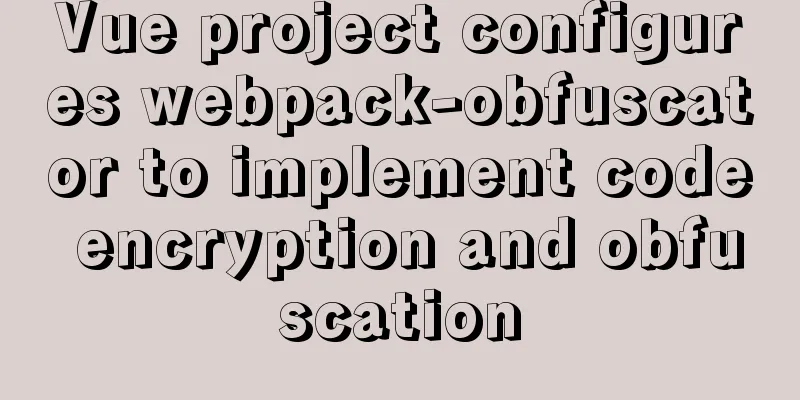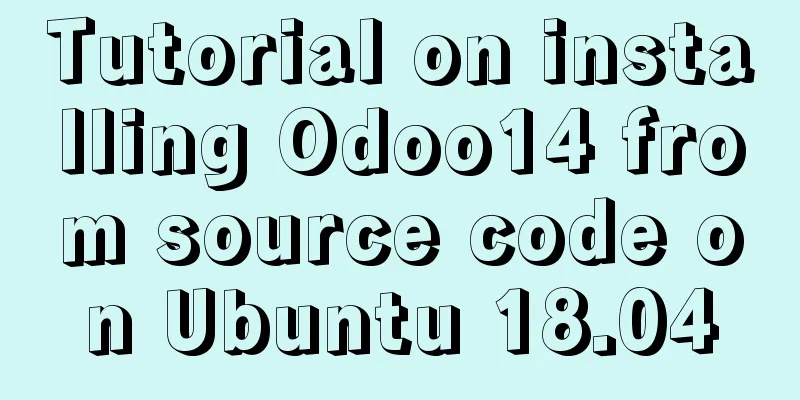Vue project configures webpack-obfuscator to implement code encryption and obfuscation

background The company code is provided to third parties for use. In order to prevent the source code from being completely leaked, the given code needs to be encrypted and obfuscated. Although the front-end code cannot be completely encrypted and obfuscated, the build code can be completely obfuscated by using Install
npm install --save-dev webpack-obfuscator Configuration
// webpack.config.js
const JavaScriptObfuscator = require('webpack-obfuscator');
module.exports = {
entry: {
'abc': './test/input/index.js',
'cde': './test/input/index1.js'
},
output: {
path: 'dist',
filename: '[name].js'
},
plugins: [
new JavaScriptObfuscator({
rotateUnicodeArray: true
// The array contains files that need to be excluded}, ['abc.js'])
]
};
// vue.config.js
const path = require('path');
var JavaScriptObfuscator = require('webpack-obfuscator');
module.exports = {
publicPath: process.env.NODE_ENV === 'production' ? './' : '/',
productionSourceMap: false,
configureWebpack: {
plugins: [
new JavaScriptObfuscator({
rotateStringArray: true,
}, [])
]
},
pwa: {},
pages: {}
}If you only want to encrypt and obfuscate during packaging, but not obfuscate when running locally, you can configure it as follows:
configureWebpack: (process.env.NODE_ENV === 'production') ? {
plugins: [
new JavaScriptObfuscator({
// ...
}, [])
]
} : {}, Buildnpm run build Build file comparison1. Original Document
//test.js
function abc() {
for (let i = 0; i < 10; i++) {
console.log(`${i}th, hello, hello`)
}
}
abc() 2.
webpackJsonp([2],{lVK7:function(o,l){!function(){for(var o=0;o<10;o++)console.log("The "+o+"th, hello, hello")}()}},["lVK7"]); 3. When
new JavaScriptObfuscator({
}, [])
var _0x1f6e=["个,你好,hello","lVK7","log"];!function(n,o){!function(o){for(;--o;)n.push(n.shift())}(++o)}(_0x1f6e,323);var _0x3655=function(n,o){return _0x1f6e[n-=0]};webpackJsonp([2],{lVK7:function(n,o){!function(){for(var n=0;n<10;n++)console[_0x3655("0x0")]("第"+n+_0x3655("0x1"))}()}},[_0x3655("0x2")]); 4. Low performance: performance is
new JavaScriptObfuscator({
// Compress code compact: true,
// Whether to enable control flow flattening (reduce running speed by 1.5 times)
controlFlowFlattening: true,
// Application probability; In larger code bases, it is recommended to lower this value, as a large number of control flow transitions may increase the size of the code and reduce the speed of the code.
controlFlowFlatteningThreshold: 1,
// Random dead code blocks (increases the size of the obfuscated code)
deadCodeInjection: true,
//Dead code block impact probability deadCodeInjectionThreshold: 1,
// This option makes it almost impossible to use the console tab of the developer tools debugProtection: true,
// If checked, will force debugging mode with intervals on the Console tab, making it more difficult to use other features of the Developer Tools.
debugProtectionInterval: true,
// Disable console.log, console.info, console.error and console.warn by replacing them with empty functions. This makes using the debugger more difficult.
disableConsoleOutput: true,
// Obfuscation method of identifier hexadecimal (hexadecimal) mangled (short identifier)
identifierNamesGenerator: 'hexadecimal',
log: false,
// Whether to enable confusion of global variables and function names renameGlobals: false,
// Move the array through fixed and random (generated when the code is obfuscated) positions. This makes it more difficult to match the order of the deleted strings with their original positions. This option is recommended if the original source code is not small, as the helper functions can draw attention.
rotateStringArray: true,
// After the code is obfuscated, you cannot use code beautification, and you need to configure cpmpat:true;
selfDefending: true,
// Remove string literals and put them in a special array stringArray: true,
stringArrayEncoding: 'rc4',
stringArrayThreshold: 1,
// Allows to enable/disable string conversion to unicode escape sequences. Unicode escape sequences significantly increase code size and make it easy to restore a string to its original view. It is recommended to enable this option only for small source codes.
transformObjectKeys: true,
unicodeEscapeSequence: false
}, []), Built file size:
var _0xa0d1=["w7Bzw6oKw6E=","wrwIUcOVw4M=","w4bChi3DtcOQ","wpLDtsK5w4LDpA==","OUlQwp1z","woEqw4XCtsOe","YR3DrkDCiA==","woAjwq/Ci8KQ","dDNzw5bDgA==",
// ...
("0x201","xatR")]=function(x){return x()},x[_0x34e6("0x202","vdcx")](_0x2c01f8)},4e3); 3. Best performance: performance is
new JavaScriptObfuscator({
// Compress code compact: true,
// Whether to enable control flow flattening (reduce running speed by 1.5 times)
controlFlowFlattening: true,
// Application probability; In larger code bases, it is recommended to lower this value, as a large number of control flow transitions may increase the size of the code and reduce the speed of the code.
controlFlowFlatteningThreshold: 0.75,
// Random dead code blocks (increases the size of the obfuscated code)
deadCodeInjection: true,
//Dead code block impact probability deadCodeInjectionThreshold: 0.4,
// This option makes it almost impossible to use the console tab of the developer tools debugProtection: false,
// If checked, will force debugging mode with intervals on the Console tab, making it more difficult to use other features of the Developer Tools.
debugProtectionInterval: false,
// Disable console.log, console.info, console.error and console.warn by replacing them with empty functions. This makes using the debugger more difficult.
disableConsoleOutput: true,
// Obfuscation method of identifier hexadecimal (hexadecimal) mangled (short identifier)
identifierNamesGenerator: 'hexadecimal',
log: false,
// Whether to enable confusion of global variables and function names renameGlobals: false,
// Move the array through fixed and random (generated when the code is obfuscated) positions. This makes it more difficult to match the order of the deleted strings with their original positions. This option is recommended if the original source code is not small, as the helper functions can draw attention.
rotateStringArray: true,
// After the code is obfuscated, you cannot use code beautification, and you need to configure cpmpat:true;
selfDefending: true,
// Remove string literals and put them in a special array stringArray: true,
stringArrayEncoding: 'base64',
stringArrayThreshold: 0.75,
transformObjectKeys: true,
// Allows to enable/disable string conversion to unicode escape sequences. Unicode escape sequences significantly increase code size and make it easy to restore a string to its original view. It is recommended to enable this option only for small source codes.
unicodeEscapeSequence: false
}, []), Built file size:
var _0x1a25=["UmFzT1U=","RkVIc0o=","VUt2eW4=","Q29IS0g=","V1NSZ0k=","d3RNT2w=","dlV6cUw=","RlpzZWg=","QnpzSlE=","cXBqQ1k=","YXBwbHk=","bFZLNw==","Y3p1Ymo=","TFZlQXE=","Y2NKWlY=","cmV0dXJuIChmdW5jdGlvbigpIA==",
// ...
(b[_0x4bcb("0x2a")]("第"+c,b[_0x4bcb("0x2b")]))}})}},[_0x4bcb("0x2f")]); 4. High performance: performance is slightly slower than without obfuscation
new JavaScriptObfuscator({
// Compress code compact: true,
// Whether to enable control flow flattening (reduce running speed by 1.5 times)
controlFlowFlattening: false,
// Random dead code blocks (increases the size of the obfuscated code)
deadCodeInjection: false,
// This option makes it almost impossible to use the console tab of the developer tools debugProtection: false,
// If checked, will force debugging mode with intervals on the Console tab, making it more difficult to use other features of the Developer Tools.
debugProtectionInterval: false,
// Disable console.log, console.info, console.error and console.warn by replacing them with empty functions. This makes using the debugger more difficult.
disableConsoleOutput: true,
// Obfuscation method of identifier hexadecimal (hexadecimal) mangled (short identifier)
identifierNamesGenerator: 'hexadecimal',
log: false,
// Whether to enable confusion of global variables and function names renameGlobals: false,
// Move the array through fixed and random (generated when the code is obfuscated) positions. This makes it more difficult to match the order of the deleted strings with their original positions. This option is recommended if the original source code is not small, as the helper functions can draw attention.
rotateStringArray: true,
// After the code is obfuscated, you cannot use code beautification, and you need to configure cpmpat:true;
selfDefending: true,
// Remove string literals and put them in a special array stringArray: true,
stringArrayEncoding: false,
stringArrayThreshold: 0.75,
// Allows to enable/disable string conversion to unicode escape sequences. Unicode escape sequences significantly increase code size and make it easy to restore a string to its original view. It is recommended to enable this option only for small source codes.
unicodeEscapeSequence: false
}, []), Built file size:
var _0x37a6=["exception","trace","console","个,你好,hello","lVK7","apply","return (function() ",'{}.constructor("return this")() ',"log","warn","debug","info","error"];!function(n,e){var o=function(e){for(;--e;)n.push(n.shift())};
// ...
[_0xe1fd("0x3")]("第"+n+_0xe1fd("0xb"))}()}},[_0xe1fd("0xc")]);Comparison table |
| File name | File size | Normal build | No parameters | Highly obfuscated | Moderate confusion | Low obfuscation |
|---|---|---|---|---|---|---|
| test.js | 117 bytes | 177 bytes | 363 bytes | 29.2 KB (29,999 bytes) | 6.90KB (7066 bytes) | 2.36 KB (2,424 bytes) |
| jquery.js | 111 KB (113,852 bytes) | 85.0 KB (87,064 bytes) | 115 KB (117,770 bytes) | 1.24 MB (1,304,998 bytes) | 401 KB (411,543 bytes) | 117 KB (120,243 bytes) |
Main Attributes
{
// Compression, no line break compact: true,
// Whether to enable control flow flattening (reduce running speed by 1.5 times)
controlFlowFlattening: false,
// Application probability; In larger code bases, it is recommended to lower this value, as a large number of control flow transitions may increase the size of the code and reduce the speed of the code.
controlFlowFlatteningThreshold: 0.75,
// Random dead code blocks (increases the size of the obfuscated code)
deadCodeInjection: false,
//Dead code block impact probability deadCodeInjectionThreshold: 0.4,
// This option makes it almost impossible to use the console tab of the developer tools debugProtection: false,
// If checked, will force debugging mode with intervals on the Console tab, making it more difficult to use other features of the Developer Tools.
debugProtectionInterval: false,
// Disable console.log, console.info, console.error and console.warn by replacing them with empty functions. This makes using the debugger more difficult.
disableConsoleOutput: false,
// Lock down obfuscated source code to only run on specific domains and/or subdomains. This makes it very difficult for someone to just copy and paste your source code and run it somewhere else.
domainLock: [],
//Obfuscation method of identifier hexadecimal (hexadecimal) mangled (short identifier)
identifierNamesGenerator: 'hexadecimal',
//Add a specific prefix to the global identifier. Use this option when obfuscating multiple files loaded on the same page. This option helps avoid conflicts between global identifiers for these files. Use a different prefix for each file identifiersPrefix: '',
inputFileName: '',
// Enable logging to the console.
log: false,
// Whether to enable confusion of global variables and function names renameGlobals: false,
// Disable obfuscation and generated identifiers reservedNames: [],
// Disable conversion of string literals reservedStrings: [],
// Move the array through fixed and random (generated when the code is obfuscated) positions. This makes it more difficult to match the order of the deleted strings with their original positions. This option is recommended if the original source code is not small, as the helper functions can draw attention.
rotateStringArray: true,
// After the code is obfuscated, you cannot use code beautification, and you need to configure cpmpat:true;
seed: 0,
selfDefending: false,
sourceMap: false,
sourceMapBaseUrl: '',
sourceMapFileName: '',
sourceMapMode: 'separate',
// Remove string literals and put them in a special array stringArray: true,
// Encode all string literals in stringArray using base64 or rc4 and insert them into a special code which decodes back at runtime. true (boolean): stringArray uses base64 encoding value; false (boolean): do not encode stringArray value; 'base64' (string): stringArray uses base64 encoding value; 'rc4' (string): stringArray uses rc4 encoding value. About 30-50% slower than base64, but harder to get the initial value. It is recommended to disable unicodeEscapeSequence option with rc4 encoding to prevent very large obfuscated codes.
stringArrayEncoding: false,
// Adjust the probability that a string literal will be inserted into stringArray stringArrayThreshold: 0.75,
// You can set the target environment for obfuscated code to one of the following: Browser; Browser No Eval; Node
target: 'browser',
// Whether to enable obfuscation of object keys transformObjectKeys: false,
// Allows to enable/disable string conversion to unicode escape sequences. Unicode escape sequences significantly increase code size and make it easy to restore a string to its original view. It is recommended to enable this option only for small source codes.
unicodeEscapeSequence: false
}Notice
- When installing
webpack-obfuscator, pay attention to the version ofwebpack-obfuscatorto match the local projectwebpackversion. I use[email protected]and the projectwebpackis version4.x(4.x版webpackwill report an error and cannot be used using the latest version[email protected], andwebpackhas not been upgraded to version5.x). -
excludes數組is compatible withmultimatch包語法, for example, it supports['js/chunk-vendors.**.js'],['excluded_bundle_name.js', '**_bundle_name.js']or'excluded_bundle_name.js', etc.
Article address: https://www.cnblogs.com/dragonir/p/14445767.html Author: dragonir
Related articles reference:
js code obfuscation
webpack-obfuscator https://blog.csdn.net/qq_31126175/article/details/86526237
This is the end of this article about configuring webpack-obfuscator in the vue project for code encryption and obfuscation. For more related vue webpack-obfuscator code obfuscation content, please search 123WORDPRESS.COM's previous articles or continue to browse the following related articles. I hope everyone will support 123WORDPRESS.COM in the future!
- Detailed explanation of how to start running the dist file generated after webpack packages the vue project
- Briefly describe how to use chainWebpack in vue-cli
<<: Tips for organizing strings in Linux
>>: Summary of special processing statements of MySQL SQL statements (must read)
Recommend
Vue implements zip file download
This article example shares the specific code of ...
How to implement communication between Docker containers
Scenario: A laradock development environment (php...
Steps to configure nginx ssl to implement https access (suitable for novices)
Preface After deploying the server, I visited my ...
Summary of some tips for bypassing nodejs code execution
Table of contents 1. child_process 2. Command exe...
Nginx reverse proxy learning example tutorial
Table of contents 1. Reverse proxy preparation 1....
Solution to inconsistent display of cursor size in input box
The cursor size in the input box is inconsistent T...
Detailed explanation of compatibility issues and solutions for setting max-width and min-width in table
Setting min-width and max-width properties in tab...
One question to understand multiple parameters of sort command in Linux
The sort command is very commonly used, but it al...
Why MySQL should avoid large transactions and how to solve them
What is a big deal? Transactions that run for a l...
HTML table tag tutorial (24): horizontal alignment attribute of the row ALIGN
In the horizontal direction, you can set the row ...
Detailed explanation of primitive values and reference values in ECMAScript
Table of contents Preface What are dynamic proper...
MySQL installation and configuration method graphic tutorial (CentOS7)
1. System environment [root@localhost home]# cat ...
Detailed explanation of using pt-heartbeat to monitor MySQL replication delay
pt-heartbeat When the database is replicated betw...
Detailed explanation of the usage of grep command in Linux
1. Official Introduction grep is a commonly used ...
Steps to build a file server using Apache under Linux
1. About the file server In a project, if you wan...










